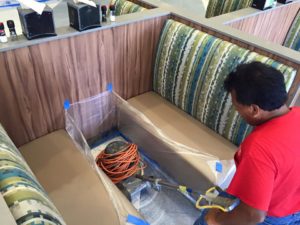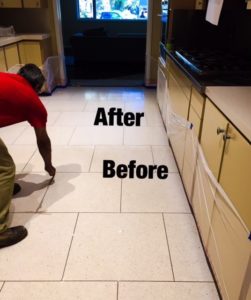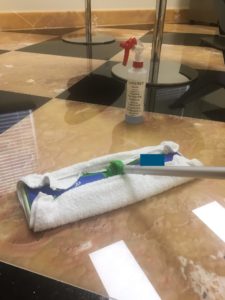It’s no secret that natural stone is our thing, but let’s be real here: we know you also love other surfaces such as carpet and wood floors. We don’t blame you at all! In fact, in this week’s blog, we’re giving you advice on how to protect your wood and carpet, while you clean and care for your natural stone surfaces. Also this week, we’re highlighting what we do as professional stone restorers to cover and protect your non-stone surfaces.

The number one step in all of our restoration projects: Protect, Protect, Protect!
We use water during the restoration process, and even though our process involves a minimal amount of water, it is vital that we protect your adjacent areas. (The good news is, because our process is a wet process, dust is not an issue during stone restoration).

When we restore a marble kitchen island or a granite countertop that is surrounded by wood floors, we create a barrier around the top to avoid spills on the floor.
When refinishing stone floors, we cover cabinets and adjacent wood and carpet with plastic masking film and Blue Painters Tape. This first step is vital to our process because we do not want to get carpet, wood floors, or cupboards wet. For larger projects, we also use a wet vacuum to reduce excess liquid.
If you were planning on touching up paint, we recommend re-painting cabinets and baseboards following your stone restoration project in order to avoid the pulling of fresh paint (even with Blue Tape).

Now that you know our process, here are some tips that will help you protect your adjacent areas during your regular stone cleaning:
1. Cleaning marble, granite and limestone countertops
Use Lavenet neutral cleaner in a spray bottle (you can dilute yourself or purchase Lavenet Ready-To-Use) or clean with Akemi Crystal Clean Spray. Cleaning countertops with a spray bottle helps you control the amount of liquid and you avoid spills on the floor. Spray and wipe: pretty simple, right?
2. Cleaning marble, travertine, limestone and terrazzo floors
For larger areas, I recommend diluting Lavenet neutral cleaner in a bucket and damp mopping with a cotton mop; do not flood the floor. If you need to detail clean corners and crevices, take time to cover the baseboards and cabinets first with plastic and Blue Tape.
For smaller areas such as powder bathroom floors, I recommend using the Lavenet Ready-To-Use spray bottle cleaner and a hard surface sweeping/mopping tool with handle, along with an untreated cloth. That way, you can safely clean your stone floor with a minimal amount of liquid.

Hopefully, this blog post will help you out with your day-to-day cleaning as well as give you insight on what we have to do as a professional restoration company to protect your adjacent carpet and wood floors.
